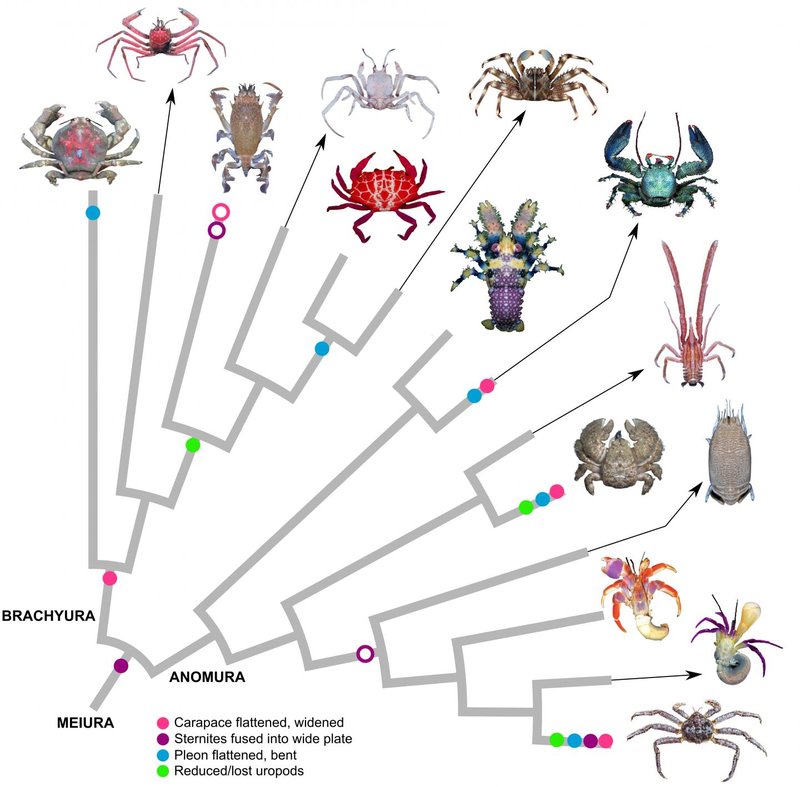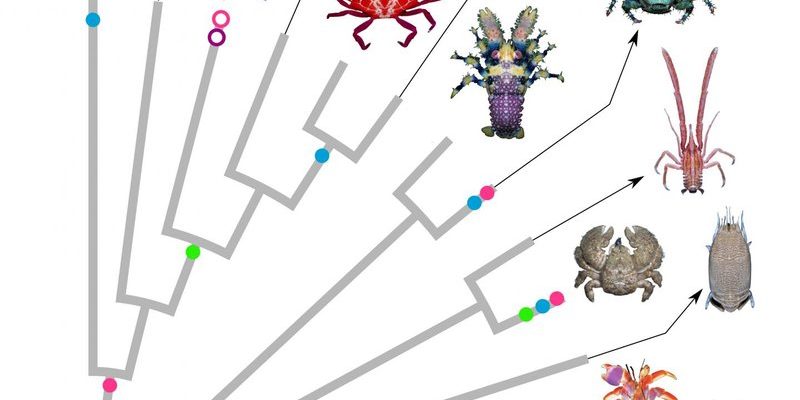
Crabs belong to a group called crustaceans, which are fascinating creatures with both familiar and bizarre relatives. Think of lobsters, shrimp, and even barnacles. They all share a common ancestor but have evolved very differently over time. Today, crabs can be found in oceans, freshwater rivers, and even on land. Their adaptability is one of the reasons they’ve thrived for so long, and exploring their evolutionary journey gives us a window into the complex web of life on our planet.
The Origins of Crabs
The story of crabs begins way back in the Cambrian period, around 500 million years ago. During this time, ancient sea creatures that looked quite different from today’s crabs roamed the waters. The earliest ancestors of crabs were soft-bodied and likely resembled modern-day shrimp more than the crabs we recognize now. They were part of a larger group known as “pancrustaceans,” which is like a big family reunion of all crustaceans.
Fast forward to the Ordovician period, about 400 million years ago, and you’d see the emergence of more recognizable features. These early crustaceans developed hard exoskeletons for protection against predators, a significant milestone in their evolutionary journey. This change allowed them to thrive in various marine environments. Over millions of years, the crab lineage began to branch out, leading to the different species we see today.
The first true crabs split off from their relatives during the Jurassic period, around 150 million years ago. This is when they began to develop their signature features: the flattened bodies, hard shells, and sideways walking ability. It’s fascinating how evolution shapes creatures in response to their environments!
Diversity of Crab Species
Today, there are over 6,800 known species of crabs, and they come in many shapes and sizes. From the tiny pea crab, which is just a few millimeters long, to the giant Japanese spider crab, boasting a leg span of over 12 feet, the diversity is astounding. Each species has adapted uniquely to its surroundings, showcasing nature’s creativity.
You might be surprised to learn that crabs can be found in every type of environment—oceans, rivers, and even on land. For instance, the coconut crab is a land-dwelling species known for its ability to climb trees and crack open coconuts. On the other hand, the king crab thrives in cold waters of the Arctic and North Pacific Oceans. These adaptations highlight how crabs have evolved to exploit different ecological niches, ensuring their survival in various habitats.
Honestly, if you take a moment to appreciate the sheer variety, it’s like going to a natural buffet where each crab species represents a different dish. You’ve got your sweet and savory, your small bites, and your hearty servings—all served up by nature!
The Crab’s Unique Features
What sets crabs apart from other crustaceans? One standout feature is their exoskeleton, which is a hard outer shell that provides protection and support. This hard shell is made of chitin, a strong, flexible material. You can think of it as a suit of armor that allows crabs to survive in harsh conditions. So, when a crab feels threatened, it can retreat into its shell, much like a turtle hiding in its shell for safety.
Another unique characteristic of crabs is their claws. These claws, or chelae, come in various shapes and sizes depending on the species. Some are used for defense, while others are excellent for foraging or displaying dominance during mating rituals. For example, the fiddler crab has one oversized claw that it waves to attract females. It’s like an extravagant dance!
Their sideways walk is also a fun fact. Crabs have a special structure in their legs that allows them to move more efficiently this way. Think of a crab as a skilled dancer, effortlessly gliding across the sandy stage of its ocean floor. This movement helps them avoid predators while navigating rocky seabeds or sandy beaches.
Crabs in Culture and Cuisine
Crabs have played an essential role in various cultures around the world. For many coastal communities, they are more than just creatures scuttling along the shore—they’re a significant source of food and income. From crab boils in the southern United States to sushi rolls featuring soft-shell crabs in Japan, these critters have found a cherished place on our plates.
In many cultures, crabs symbolize prosperity and good fortune. For instance, in some Asian cultures, they are considered a delicacy for special occasions, often given as gifts to celebrate milestones. The crab’s ability to thrive in different environments mirrors the adaptability and resilience many people admire.
You might even find crabs in stories and folklore. Take the famous story of the crab and the turtle, where they team up to overcome challenges together. These tales remind us that the journey of crabs is intertwined with human lives, connecting us to nature on a deeper level.
The Future of Crabs
As we look to the future, crabs face several challenges. Climate change, pollution, and habitat loss are major threats to their populations. Ocean warming affects the delicate ecosystems that crabs depend on, and changes in water acidity can impact their ability to build shells. It’s concerning because crabs not only play a vital role in marine ecosystems but also support many fisheries worldwide.
Conservation efforts are crucial to ensuring crabs thrive for generations to come. Simple actions like reducing plastic use, supporting sustainable fishing practices, and protecting coastal habitats can all help. It’s a collective effort, and every individual can contribute.
You might be wondering why we should care about crabs. Aside from their ecological significance, crabs remind us of the intricate web of life. Every creature, no matter how small, has a role in maintaining balance in our ecosystems. Protecting crabs ultimately helps protect our environment.
The evolutionary journey of the crab is a captivating tale spanning millions of years. From their ancient ancestors to the diverse species we see today, crabs showcase nature’s adaptability and resilience. They’re not just fascinating creatures; they’re part of our culture, our cuisine, and our ecosystem.
As we celebrate crabs and their incredible history, let’s also remember the importance of protecting the environments they inhabit. After all, their story isn’t just about survival; it’s about the interconnectedness of all life on Earth.
So next time you spot a crab scuttling by, take a moment to appreciate its journey. You might just find yourself inspired by the remarkable evolutionary tale unfolding right before your eyes.

